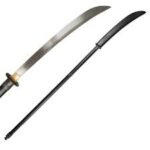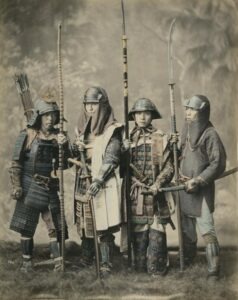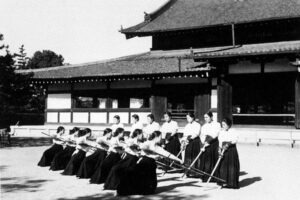
A traditional Japanese martial art that revolves around the use of a weapon known as the naginata, which is a long polearm with a curved blade at the end. Its name was first visible in the Kojiki1 (A Record of Ancient Matters, 712). The practice of naginatajutsu has historical roots, dating back to feudal Japan, where the weapon was primarily used by samurai women for self-defense.
History and Origins

Naginatajutsu originated in the late Heian period (794–1185) and gained prominence during the Kamakura period (1185–1333). Initially, the naginata was associated with the battlefield, but over time, its use transitioned to a civilian context, particularly among the samurai class.
In the year 1086, the book titled “Oushu Gosannenki” (A Diary of Three Years in Oushu) documented the earliest recorded instances of the naginata being employed in combat. During this era, warriors considered the naginata an exceptionally effective weapon. However, as the 1500s unfolded, the advent of muskets and large-scale battles led to the transformation of the naginata into a specialized weapon, predominantly wielded by warrior priests and women.
Weapon Design
The naginata consists of a long wooden shaft, often made from oak or other durable woods, with a curved blade attached to one end. The blade is single-edged and resembles a katana, though it is mounted on a pole, providing a longer reach. The weapon’s design allows for effective strikes and sweeps, making it versatile in both offensive and defensive maneuvers.

Techniques and Training

Naginatajutsu training involves mastering a wide range of techniques, including strikes, thrusts, sweeps, and blocks. Practitioners learn how to effectively utilize the weapon’s length to maintain a safe distance from opponents. The art emphasizes fluid movements, footwork, and precise timing. Training often involves solo and paired drills, as well as kata (pre-arranged forms) that simulate combat scenarios.
Modern Practice
In contemporary times, naginata has evolved into a sport practiced by both men and women. Competitive naginata involves sparring matches where practitioners demonstrate their skill in striking and defending. Points are awarded based on successful techniques and effective control of the naginata. Tournaments and competitions provide a platform for practitioners to showcase their abilities and compete at various levels.
Cultural Significance
Beyond its martial aspects, naginata holds cultural significance in Japan. It is often featured in traditional Japanese arts, including Noh2 and Kabuki3 theater, where it symbolizes elegance and grace. The naginata’s association with female warriors also contributes to its representation in folklore and historical narratives.
Benefits of Practicing Naginata
1. Physical Fitness: Naginata training enhances overall physical fitness, promoting strength, flexibility, and cardiovascular health.
2. Discipline and Focus: Like many martial arts, naginata instills discipline and mental focus, requiring practitioners to concentrate on precise movements and strategies.
3. Self-Defense Skills: Learning naginata equips practitioners with self-defense techniques that can be applied in real-life situations.
4. Cultural Connection: Engaging in naginata allows individuals to connect with Japan’s rich martial history and cultural heritage.
Concluding remark
Naginata is a dynamic martial art that combines historical tradition with modern sportsmanship. Whether practiced for self-defense, physical fitness, or cultural appreciation, naginata offers a unique and rewarding experience for martial artists of all levels.
Thanks for taking the time to read it.
Gert
Footnotes
1 Japan’s archipelago creation narrative can be divided into the birth of the deities (Kamiumi) and the birth of the land (Kuniumi). The birth of the deities begins with the appearance of the first generation of gods who appeared out of primordial oil, a trio of gods who produced the next seven generations of gods. Izanagi and Izanami were eventually born, siblings, and using a naginata decorated with jewels, named Ame-no-nuhoko (“Heavenly Jeweled Spear”) that was gifted to them. Izanagi created the first islands of the Japanese Archipelago by dipping the Naginata into the primordial waters. Historians have interpreted the myth of Izanagi’s creation of the first Japanese Island Onogoro as an early example of phallocentrism in Japanese mythology.
2 Noh is a traditional form of Japanese theater that has its roots in the 14th century. It combines elements of dance, drama, music, and poetry to create a highly stylized and symbolic performance.
3 Kabuki is a traditional form of Japanese theater that originated in the early 17th century. It is known for its stylized drama, elaborate makeup, vibrant costumes, and the exaggerated gestures of its performers.
Share this article